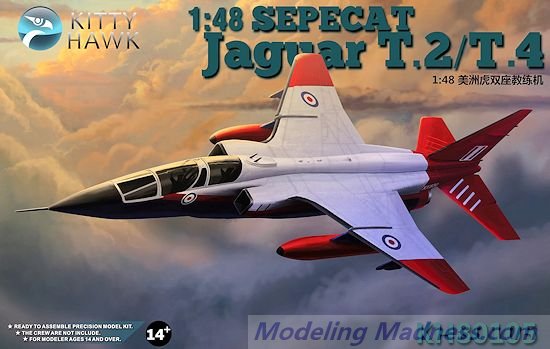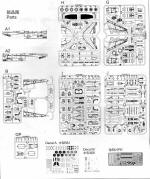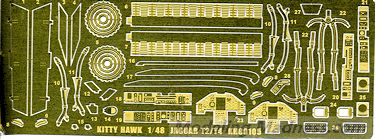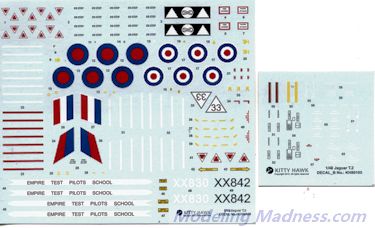
Kitty Hawk 1/48 Jaguar T.2/T.4
| KIT #: | KH 80105 |
| PRICE: | $69.99 SRP |
| DECALS: | Two Options |
| REVIEWER: | Scott Van Aken |
| NOTES: |

| HISTORY |
The SEPECAT Jaguar is an Anglo-French jet ground attack aircraft, originally used by the British Royal Air Force and the French Armée de l'Air in the close air support and nuclear strike role, and still in service with several export customers, notably the Indian Air Force and the Royal Air Force of Oman.
Originally conceived in the 1960s as jet trainer with a light ground attack capability, the requirement for the aircraft soon changed to include supersonic performance, reconnaissance and tactical nuclear strike roles. A carrier-based variant was also planned for French service, but this was cancelled in favour of the cheaper Dassault Super Étendard. The airframes were manufactured by SEPECAT (Société Européenne de Production de l'avion Ecole de Combat et d'Appui Tactique), a joint venture between Breguet and the British Aircraft Corporation, one of the first major joint-Anglo-French military aircraft programs.
The Jaguar was successfully exported to India, Oman, Ecuador and Nigeria. With various air forces, the Jaguar was used in numerous conflicts and military operations in Mauritania, Chad, Iraq, Bosnia, and Pakistan, as well as providing a ready nuclear delivery platform for Britain, France, and India throughout the latter half of the Cold War and beyond. In the Gulf War, the Jaguar was praised for its reliability and was a valuable coalition resource. The aircraft served with the Armée de l'Air as the main strike/attack aircraft until 1 July 2005, and with the Royal Air Force until the end of April 2007. It was replaced by the Panavia Tornado and the Eurofighter Typhoon in the RAF and the Dassault Rafale in the Armée de l'Air. India plans in the long term to replace its Jaguar fleet with the developing Advanced Medium Combat Aircraft (AMCA).
| THE KIT |
 This
is the third boxing of the Jaguar by Kitty Hawk Models and the first two seater
to be released. As you'd expect, the kit is pretty much the same as the single
seat version aside from the new nose and the required bits for the cockpit. I'm
a real fan of this plane and since I like two seaters, that only doubles my
liking of this particular boxing.
This
is the third boxing of the Jaguar by Kitty Hawk Models and the first two seater
to be released. As you'd expect, the kit is pretty much the same as the single
seat version aside from the new nose and the required bits for the cockpit. I'm
a real fan of this plane and since I like two seaters, that only doubles my
liking of this particular boxing.
Looking at the parts in this kit, one notices that the engraving is quite nice and while it is crisper than what you'll find in some engraved kits, it is also a bit softer than what one would expect from Tamiya or Hasegawa. The panel lines are more like new Airfix in that respect, something that most modelers will not mind and pretty typical of what we get out of Chinese kit makers nowadays.
 The kit
comes with a nicely done photo etch fret that includes instrument panel faces,
side console faces, a harness for the seats, a flame director for the exhaust as
well as the detail for the inside of the burner petal section. The wing mounted
speed brakes, wing fences and some antennas are also done in photo etch. Kitty
Hawk has made a corporate decision to do their instrument panels in photo etch
and while the etching is really very good, it is also rather 'flat'. Personally, I'd prefer molded on detail with a
decal to put over it. I would also rather have the p.e. antennas as a option
along with plastic ones as often on a
model of this scale, standard ejection molded antennas would be
just as good if not better. The seat is fairly nice and there are p.e. belts for
it. As a note, there are optional pieces of p.e. for the instrument panels, but
no indication of which is for which markings option.
The kit
comes with a nicely done photo etch fret that includes instrument panel faces,
side console faces, a harness for the seats, a flame director for the exhaust as
well as the detail for the inside of the burner petal section. The wing mounted
speed brakes, wing fences and some antennas are also done in photo etch. Kitty
Hawk has made a corporate decision to do their instrument panels in photo etch
and while the etching is really very good, it is also rather 'flat'. Personally, I'd prefer molded on detail with a
decal to put over it. I would also rather have the p.e. antennas as a option
along with plastic ones as often on a
model of this scale, standard ejection molded antennas would be
just as good if not better. The seat is fairly nice and there are p.e. belts for
it. As a note, there are optional pieces of p.e. for the instrument panels, but
no indication of which is for which markings option.
 y
light on armament and would not have the over wing Sidewinder rails. Again,
get photos to see what would be applicable. Despite showing two large under
wing fuel tanks on the box art, only one is supplied and that one is for the
centerline pylon.
y
light on armament and would not have the over wing Sidewinder rails. Again,
get photos to see what would be applicable. Despite showing two large under
wing fuel tanks on the box art, only one is supplied and that one is for the
centerline pylon.
Instructions are well done with Gunze paint references. It seems to be typical of many modern kits that you are supposed to completely build the nose section and the rear fuselage section with all the weapons attached before joining them together. I would hazard a guess that the person who developed the instruction sheet has never actually built a model or is quite young and not fumble-fingered. Markings are for two planes. One is the very colorful box art airplane from the Empire Test Pilot's School in the 'raspberry ripple' scheme. The other is from 2 Squadron in a standard green/grey wrap camouflage scheme. The decal sheet is well done and includes a lot of weapons markings as well as those for the two aircraft options.
| CONCLUSIONS |
In all, a very nice and most welcome kit. My experience building the Mirage F.1B kit a while back showed that the kit needs to be built carefully, dry fitting pretty much all the major parts to ensure a good fit. It will require some modeling skill and patience, but the end result will be more that worth your efforts.
| REFERENCES |
http://en.wikipedia.org/wiki/SEPECAT_Jaguar
May 2014
Thanks to Kitty Hawk Models for the preview kit. You can find this kit at your favorite
hobby shop or on-line retailer.
If you would like your product reviewed fairly and fairly
quickly, please
contact
the editor or see other details in the
Note to
Contributors.